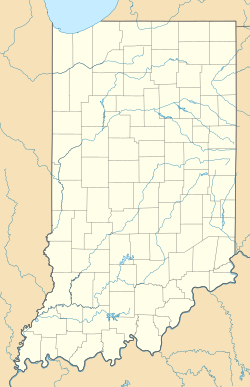The Allen County Courthouse is located at the block surrounded by Clinton/Calhoun/Main/Berry Streets in downtown Fort Wayne, Indiana, the county seat of Allen County. Built between 1897 and 1902, it is a nationally significant example of Beaux-Arts architecture. It was listed on the National Register of Historic Places in 1976 and was designated a National Historic Landmark on July 31, 2003.
Allen County Courthouse | |
 Allen County Courthouse | |
| Location | 715 South Calhoun Street, Fort Wayne, Indiana, United States |
|---|---|
| Coordinates | 41°4′47″N 85°8′21″W / 41.07972°N 85.13917°W |
| Area | about 1 acre (0.40 ha) |
| Built | 1902 |
| Architect | Brentwood S. Tolan |
| Architectural style | Beaux-Arts |
| NRHP reference No. | 76000031[1] |
| Significant dates | |
| Added to NRHP | May 28, 1976 |
| Designated NHL | July 31, 2003[2] |
History
editDesigned by Brentwood S. Tolan, construction began in 1897, the cornerstone was laid November 17, 1897. The building was dedicated September 23, 1902, with a final cost of $817,553.59 ($250 million today). Present at its dedication were Mayor Henry C. Berghoff and Governor Winfield T. Durbin. President Theodore Roosevelt was scheduled to attend, however, he ultimately was not present. On September 23, 2002, the building was re-dedicated on its centennial after a seven-year restoration effort, which cost $8.6 million.[3]
Architectural details
editThe Beaux-Arts architecture-style structure includes such features as four 25-by-45-foot (7.6 m × 13.7 m) murals by Charles Holloway, twenty-eight different kinds of scagliola covering 15,000 square feet (1,400 m2), bas-reliefs and art glass. Each of the five court rooms has its own color scheme.
Atop the building is a 255-foot (78 m)-high copper-clad domed rotunda, itself topped by a 14-foot (4.3 m) statue wind vane of Lady Liberty. The larger than life statue has feet that would wear a woman's shoe size of 28.[citation needed]
The building materials include Bedford Limestone and Vermont granite with Italian marble details. A tunnel was constructed to connect the Courthouse with the City-County Building located across the street. The Courthouse also houses a fallout shelter underground. The skylights originally built into the building were covered during World War II and replaced with artificial light.[citation needed]
The 2001 National Historic Landmark Nomination says in its opening paragraph: "An elaborate combination of Greek, Roman, and Renaissance influences, the massive courthouse reflects the exuberant ambition of late nineteenth century America."[4]
See also
editNotes
edit- ^ "National Register Information System". National Register of Historic Places. National Park Service. March 13, 2009.
- ^ "Allen County Courthouse". National Historic Landmark summary listing. National Park Service. Archived from the original on October 8, 2012. Retrieved July 23, 2008.
- ^ (2002-09-23). Restoration does justice—The finished work awes and amazes visitors. The News-Sentinel. Retrieved on 2009-07-25.
- ^ Christine Wiltberger; Carolyn Pitts; Patty Henry (May 5, 2001). National Historic Landmark Nomination: Allen County Courthouse (pdf). National Park Service. and Accompanying 52 page of photos and credits, exterior and interior, from 1999 and undated (32 KB)
References
edit- Hawfield, Michael and Michael Westfall, The Allen County Court House: A National Treasure Restored'. The Allen County Court House Preservation Trust, Guild Press, 2002.

